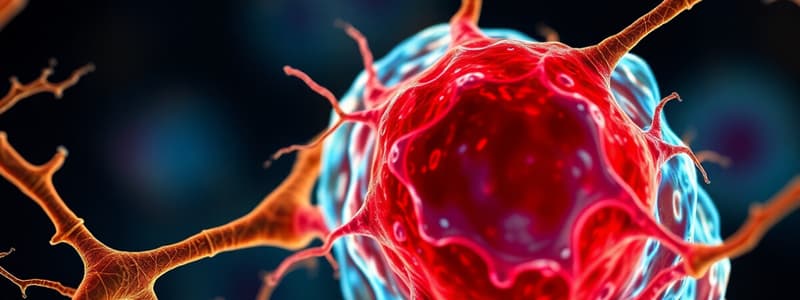Podcast
Questions and Answers
What type of junction permits the passage of ions and smaller molecules between cells?
What type of junction permits the passage of ions and smaller molecules between cells?
- Focal adhesion
- Desmosome
- Gap junction (correct)
- Chemical synapse
Which junction type is primarily responsible for providing mechanical strength to tissues subjected to stress?
Which junction type is primarily responsible for providing mechanical strength to tissues subjected to stress?
- Gap junction
- Chemical synapse
- Anchoring junction (correct)
- Tight junction
Which of the following substances can pass through gap junctions?
Which of the following substances can pass through gap junctions?
- Lipids and starch
- Large polysaccharides
- Proteins heavier than 1,000 molecular weight
- Ions and glucose (correct)
Which junction connects two nerve fibers through the release of chemical transmitters?
Which junction connects two nerve fibers through the release of chemical transmitters?
What is the function of adherens junctions?
What is the function of adherens junctions?
Which type of anchoring junction connects a cell to the extracellular matrix?
Which type of anchoring junction connects a cell to the extracellular matrix?
What is the primary role of gap junctions in cardiac tissue?
What is the primary role of gap junctions in cardiac tissue?
Which of the following is NOT a type of anchoring junction?
Which of the following is NOT a type of anchoring junction?
What is the primary function of occluding junctions?
What is the primary function of occluding junctions?
Which type of junction is characterized by the prevention of large molecules from passing between cells?
Which type of junction is characterized by the prevention of large molecules from passing between cells?
How do tight junctions contribute to the maintenance of cell polarity?
How do tight junctions contribute to the maintenance of cell polarity?
What role do tight junctions play in the blood-brain barrier?
What role do tight junctions play in the blood-brain barrier?
Which type of cell junction permits the intercellular exchange of substances?
Which type of cell junction permits the intercellular exchange of substances?
What is one of the functions of tight junctions regarding selective permeability?
What is one of the functions of tight junctions regarding selective permeability?
What is NOT a characteristic of tight junctions?
What is NOT a characteristic of tight junctions?
Which of the following best describes the anchoring junctions?
Which of the following best describes the anchoring junctions?
Flashcards are hidden until you start studying
Study Notes
Definition and Classification
- Cell junctions are connections between neighboring cells or between a cell and the extracellular matrix.
- Three primary types of cell junctions:
- Occluding junctions
- Communicating junctions
- Anchoring junctions
Occluding Junctions
- Occluding junctions prevent intercellular exchange of substances and inhibit the movement of ions and molecules.
- Example: Tight junctions, or zonula occludens, found in epithelial and endothelial cells.
Tight Junctions
- Located at the apical margins of various cells, including those in the intestinal mucosa, renal tubules, capillary walls, and choroid plexus.
- Functions:
- Strength and Stability: Holds neighboring cells firmly together, providing structural integrity.
- Selective Permeability (Gate Function): Acts as a barrier for small molecules and a complete barrier for larger molecules, regulating ion and water interchange.
- Fencing Function: Prevents lateral movement of membrane proteins and lipids, maintaining distinct cell surface regions.
- Maintenance of Cell Polarity: Keeps proteins localized to the apical region.
- Blood-Brain Barrier: Creates a selective barrier in brain capillaries, allowing only lipid-soluble substances to pass.
Communicating Junctions
- Communicating junctions enable the exchange of ions and small molecules between adjacent cells.
- Examples: Gap junctions and chemical synapses.
Gap Junctions
- Facilitate the passage of ions and smaller molecules, found in the heart and basal part of intestinal epithelial cells.
- Functions:
- Allows the transfer of glucose, amino acids, and ions under a molecular weight threshold.
- Facilitates rapid chemical messenger exchange.
- Enables quick propagation of action potentials, a rapid voltage change across a membrane.
Chemical Synapse
- A junction between nerve fibers or between a nerve fiber and a muscle fiber where signals are transmitted via chemical transmitters.
Anchoring Junctions
- Provide mechanical strength and attachment between cells or between cells and the extracellular matrix.
- Critical for structural integrity, especially in tissues experiencing mechanical stress like heart muscle and skin epidermis.
Types of Anchoring Junctions
-
Actin Filament Attachments:
- Adherens Junctions: Connect cells to each other.
- Focal Adhesions: Connect cells to the extracellular matrix.
-
Intermediate Filament Attachments:
- Desmosomes: Connect neighboring cells for strength.
- Hemidesmosomes: Anchor cells to the extracellular matrix.
Studying That Suits You
Use AI to generate personalized quizzes and flashcards to suit your learning preferences.




